Chapter 3
Prescriptive Process Models
CHAPTER OVERVIEW AND COMMENTS
This intent of this chapter is to present process models used by professional software developers to manage large-scale software projects. No software process works well for every project. However, every project needs to conform to some systematic process in order to manage software development activities that can easily get out of control. Software processes help to organize the work products that need to be produced during a software development project. Ultimately the best indicator of how well a software process has worked is the quality of the deliverables produced. A well-managed process will produce high quality products on time and within budget.
3.1 Prescriptive Models
Many people (and not a few professors) believe that prescriptive models are “old school”—ponderous, bureaucratic document-producing machines.
3.2 The Waterfall Model

Many people dismiss the waterfall as obsolete and it certainly does have problems. But this model can still be used in some situations.
Among the problems that are sometimes encountered when the waterfall model is applied are:
3.3 Incremental Process Models
The process models in this category tend to be among the most widely used (and effective) in the industry.
3.3.1 The Incremental Model
The incremental model combines elements of the waterfall model applied in an iterative fashion. The model applies linear sequences in a staggered fashion as calendar time progresses.
Each linear sequence produces deliverable “increments” of the software. (Ex: a Word Processor delivers basic file mgmt., editing, in the first increment; more sophisticated editing, document production capabilities in the 2nd increment; spelling and grammar checking in the 3rd increment.
When an increment model is used, the 1st increment is often a core product. The core product is used by the customer.
As a result of use and / or evaluation, a plan is developed for the next increment.
The plan addresses the modification of the core product to better meet the needs of the customer and the delivery of additional features and functionality.
The process is repeated following the delivery of each increment, until the complete product is produced.
If the customer demands delivery by a date that is impossible to meet, suggest delivering one or more increments by that date and the rest of the Software later.
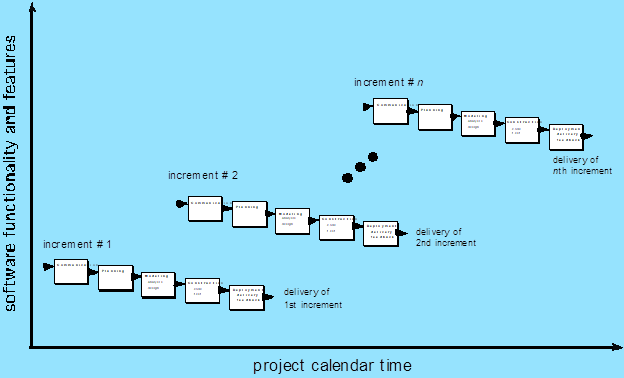
3.3.1 The RAD Model
Rapid Application Development (RAD) is an incremental software process model that emphasizes a short development cycle.
RAD is a “high-speed” adaptation of the waterfall model, in which rapid development is achieved by using a component based construction approach.
If requirements are well understood and project scope is constrained, the RAD process enables a development team to create a fully functional system within a short period of time.
What are the drawbacks of the RAD model?
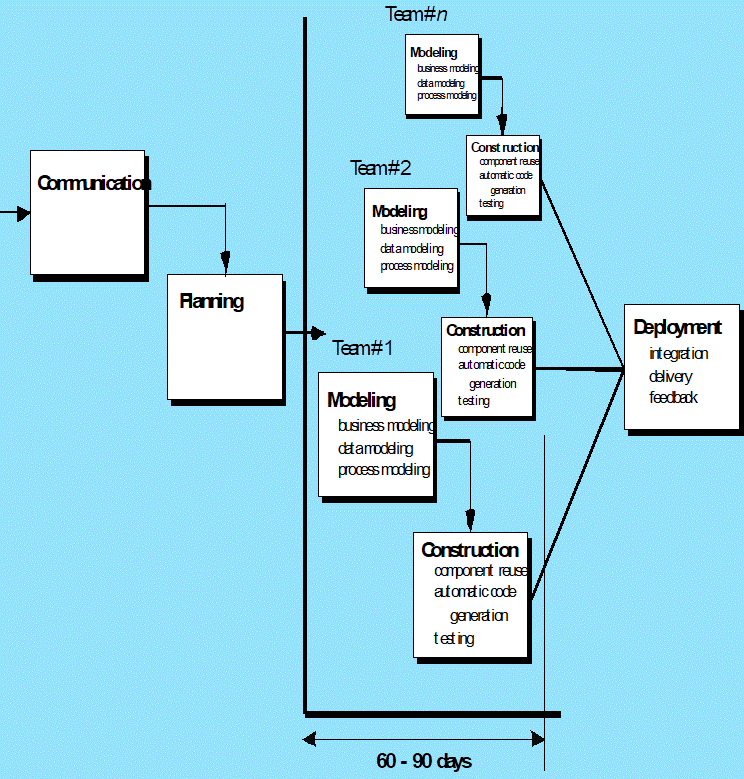
3.4 Evolutionary Process Models
Software evolves over a period of time; business and product requirements often change as development proceeds, making a straight-line path to an end product unrealistic.
Software Engineering needs a process model that has been explicitly designed to accommodate a product that evolves over time.
Evolutionary process models are iterative. They produce increasingly more complete versions of the Software with each iteration.
Customers often define a set of general objectives for Software, but doesn’t identify detailed input, processing, or input requirements.
Prototyping paradigm assists the Software engineering and the customer to better understand what is to be built when requirements are fuzzy.
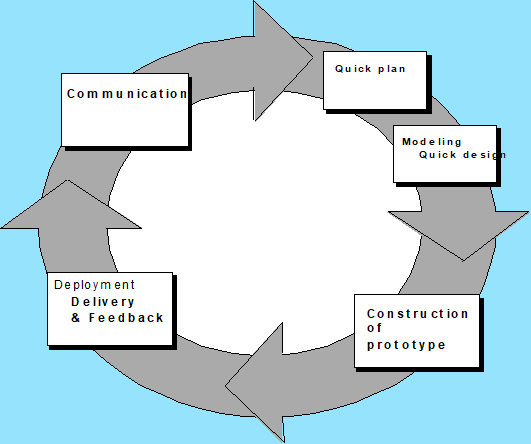
The prototyping paradigm begins with communication where requirements and goals of Software are defined.
Prototyping iteration is planned quickly and modeling in the form of quick design occurs.
The quick design focuses on a representation of those aspects of the Software that will be visible to the customer “Human interface”.
The quick design leads to the Construction of the Prototype.
The prototype is deployed and then evaluated by the customer.
Feedback is used to refine requirements for the Software.
Iteration occurs as the prototype is tuned to satisfy the needs of the customer, while enabling the developer to better understand what needs to be done.
The prototype can serve as the “first system”. Both customers and developers like the prototyping paradigm as users get a feel for the actual system, and developers get to build Software immediately. Yet, prototyping can be problematic:
The key is to define the rules of the game at the beginning. The customer and the developer must both agree that the prototype is built to serve as a mechanism for defining requirements.
The spiral model is an evolutionary Software process model that couples the iterative nature of prototyping with the controlled and systematic aspects of the waterfall model.
It has two distinguishing features:
Using the spiral model, Software is developed in a series of evolutionary releases.
During early stages, the release might be a paper model or prototype.
During later iterations, increasingly more complete versions of the engineered system are produced.
A spiral model is divided into a set of framework activities divided by the Software engineering team.
As this evolutionary process begins, the Software team performs activities that are implied by a circuit around the spiral in a clockwise direction, beginning at the center.
Risk is considered as each revolution is made.
Anchor-point milestones – a combination of work products and conditions that are attained along the path of the spiral- are noted for each evolutionary pass.
The first circuit around the spiral might result in the development of a product specification; subsequent passes around the spiral might be used to develop a prototype and then progressively more sophisticated versions of the Software.
Each pass through the planning region results in adjustments to the project plan. Cost and schedule are adjusted based on feedback derived from the customer after delivery.
Unlike other process models that end when Software is delivered, the spiral model can be adapted to apply throughout the life of the Software.
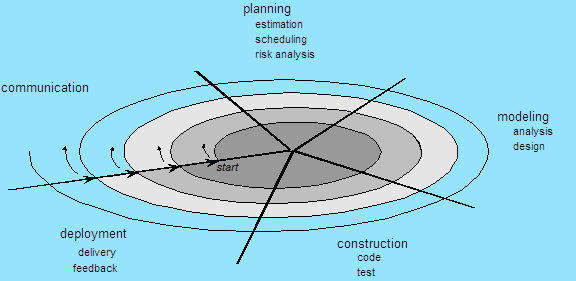
The concurrent development model, sometimes called concurrent engineering, can be represented schematically as a series of framework activities, Software engineering actions of tasks, and their associated states.
The concurrent model is often more appropriate for system engineering projects where different engineering teams are involved.
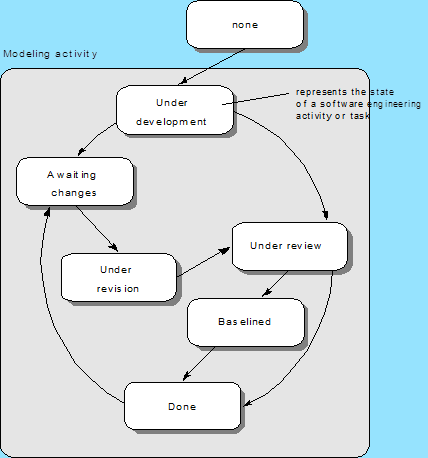
Figure above provides a schematic representation of one Software engineering task within the modeling activity for the concurrent process model. The activity – modeling- may be in any one of the states noted at any given time.
All activities exist concurrently but reside in different states.
For example, early in the project the communication activity has completed its first iteration and exists in the awaiting changes state. The modeling activity which existed in the none state while initial communication was completed now makes a transition into underdevelopment state.
If, however, the customer indicates the changes in requirements must be made, the modeling activity moves from the under development state into the awaiting changes state.
The concurrent process model defines a series of events that will trigger transitions from state to state for each of the Software engineering activities, actions, or tasks.
Specialized Process Models
3.5.1 Component Based Development
Commercial off-the-shelf (COTS) Software components, developed by vendors who offer them as products, can be used when Software is to be built. These components provide targeted functionality with well-defined interfaces that enable the component to be integrated into the Software.
The component-based development model incorporates many of the characteristics of the spiral model.
The component-based development model incorporates the following steps:
The component-based development model leads to Software reuse, and reusability provides Software engineers with a number of measurable benefits.
3.5.1 The Formal Methods Model
The Formal Methods Model encompasses a set of activities that leads to formal mathematical specifications of Software.
Formal methods enable a Software engineer to specify, develop, and verify a computer-based system by applying a rigorous, mathematical notation.
A variation of this approach, called clean-room Software engineering is currently applied by some software development organizations.
http://www.sei.cmu.edu/str/descriptions/cleanroom.html
Although not a mainstream approach, the formal methods model offers the promise of defect-free Software. Yet, concern about its applicability in a business environment has been voiced:
3.5.3 Aspect-Oriented Software Development
Regardless of the software process that is chosen, the builders of complex software invariably implement a set of localized features, functions, and information content. For further information read book page 61.
3.6 The Unified Process
A “use-case driven, architecture-centric, iterative and incremental” software process closely aligned with the Unified Modeling Language (UML).
http://www.jeckle.de/files/uniproc.pdf, http://www-01.ibm.com/software/awdtools/rup/
The UP is an attempt to draw on the best features and characteristics of conventional software process models, but characterize them in a way that implements many of the best principles of agile software development.
The UP recognizes the importance of customer communication and streamlined methods for describing the customer’s view of a system.
It emphasizes the important role of software architecture and “helps the architect focus on the right goals, such as understandability, reliance to future changes, and reuse.”
UML provides the necessary technology to support Object Oriented Software Engineering practice, but it doesn’t provide the process framework to guide project teams in their application of the technology.
The UML developers developed the Unified Process, a framework Object Oriented Software Engineering using UML.
3.6.2 Phases of the Unified Process
The figure below depicts the phases of the UP and relates them to the generic activities.
The Inception phase of the UP encompasses both customer communication and planning activities.
By collaborating with the customer and end-users, business requirements for the software are identified, a rough architecture for the system is proposed, and a plan for the iterative, incremental nature of the ensuing project is developed.
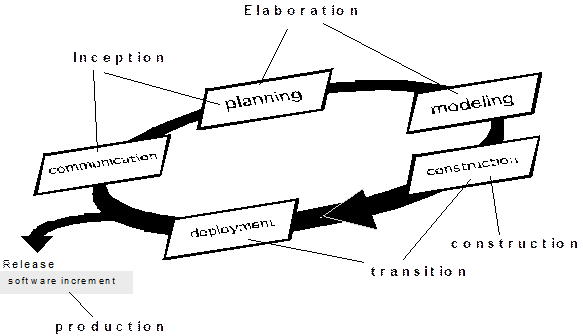
A use-case describes a sequence of actions that are performed by an actor (person, machine, another system) as the actor interacts with the Software.
The elaboration phase encompasses the customer communication and modeling activities of the generic process model. Elaboration refines and expands the preliminary use-cases that were developed as part of the inception phase and expands the architectural representation to include five different views of the software - the use-case model, the analysis model, the design model, the implementation model, and the deployment model.
The construction phase of the UP is identical to the construction activity defined for the generic software process.
Using the architectural model as input, the construction phase develops or acquires the software components that will make each use-case operational for end-users.
The transition phase of the UP encompasses the latter stages of the generic construction activity and the first part of the generic deployment activity.
Software is given to end-users for beta testing, and user feedback reports both defects and necessary changes.
At the conclusion of the transition phase, the software increment becomes a usable software release “user manuals, trouble-shooting guides, and installation procedures.)
The production phase of the UP coincides with the development activity of the generic process.
The on-going use of the software is monitored, support for the operating environment is provided and defect reports and requests for changes are submitted and evaluated.
A Software Engineering workflow is distributed across all UP phases.
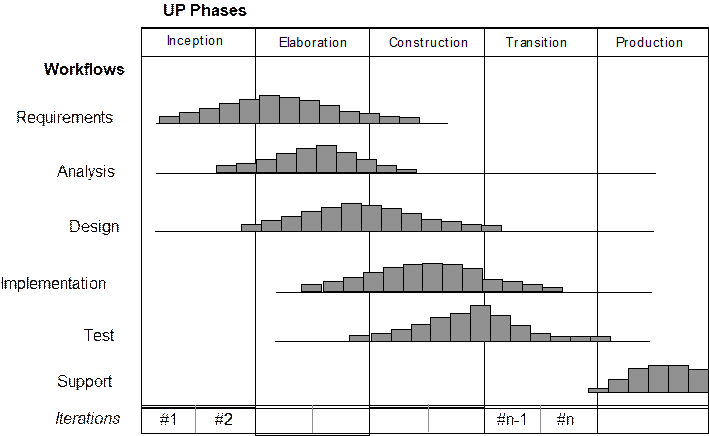
http://www.uml.org/ is the UML® Resource Page. Please link to it and familiarize yourself with it.
Source: https://www2.southeastern.edu/Academics/Faculty/galkadi/285/notes/Chapter3.doc
Web site to visit: https://www2.southeastern.edu
Author of the text: indicated on the source document of the above text
If you are the author of the text above and you not agree to share your knowledge for teaching, research, scholarship (for fair use as indicated in the United States copyrigh low) please send us an e-mail and we will remove your text quickly. Fair use is a limitation and exception to the exclusive right granted by copyright law to the author of a creative work. In United States copyright law, fair use is a doctrine that permits limited use of copyrighted material without acquiring permission from the rights holders. Examples of fair use include commentary, search engines, criticism, news reporting, research, teaching, library archiving and scholarship. It provides for the legal, unlicensed citation or incorporation of copyrighted material in another author's work under a four-factor balancing test. (source: http://en.wikipedia.org/wiki/Fair_use)
The information of medicine and health contained in the site are of a general nature and purpose which is purely informative and for this reason may not replace in any case, the council of a doctor or a qualified entity legally to the profession.
The texts are the property of their respective authors and we thank them for giving us the opportunity to share for free to students, teachers and users of the Web their texts will used only for illustrative educational and scientific purposes only.
All the information in our site are given for nonprofit educational purposes